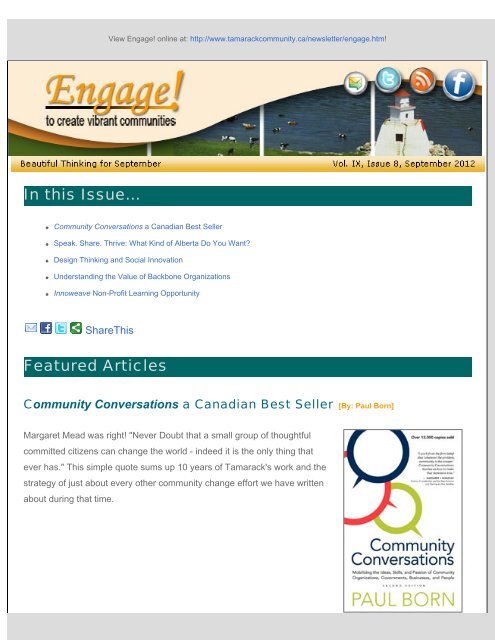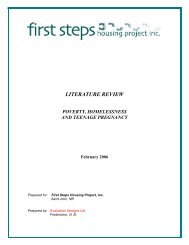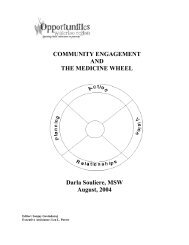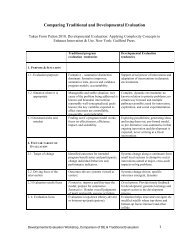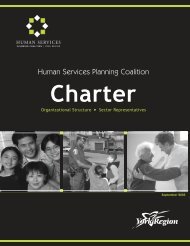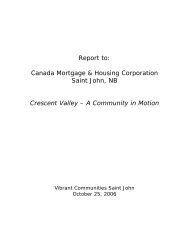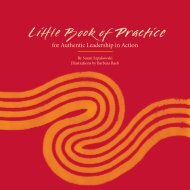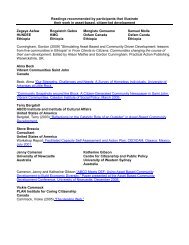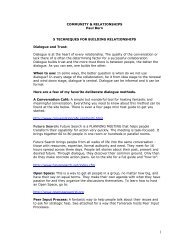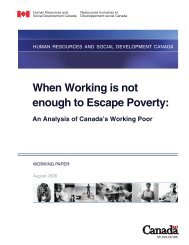Engage! to create Vibrant Communities - Tamarack
Engage! to create Vibrant Communities - Tamarack
Engage! to create Vibrant Communities - Tamarack
Create successful ePaper yourself
Turn your PDF publications into a flip-book with our unique Google optimized e-Paper software.
View <strong>Engage</strong>! online at: http://www.tamarackcommunity.ca/newsletter/engage.htm!<br />
In this Issue...<br />
●<br />
●<br />
●<br />
●<br />
●<br />
Community Conversations a Canadian Best Seller<br />
Speak. Share. Thrive: What Kind of Alberta Do You Want<br />
Design Thinking and Social Innovation<br />
Understanding the Value of Backbone Organizations<br />
Innoweave Non-Profit Learning Opportunity<br />
ShareThis<br />
Featured Articles<br />
Community Conversations a Canadian Best Seller [By: Paul Born]<br />
Margaret Mead was right! "Never Doubt that a small group of thoughtful<br />
committed citizens can change the world - indeed it is the only thing that<br />
ever has." This simple quote sums up 10 years of <strong>Tamarack</strong>'s work and the<br />
strategy of just about every other community change effort we have written<br />
about during that time.
To celebrate the work of these innova<strong>to</strong>rs of change, we have just released a second edition of Community<br />
Conversations. The book I wrote 4 years ago has sold over 15,000 copies, making it a Canadian best seller.<br />
As <strong>Tamarack</strong>'s work in the United States continues <strong>to</strong> grow this edition is appealing <strong>to</strong> that audience and<br />
beyond.<br />
Community Conversations: Mobilizing the Ideas, Skill and Passion of Community Organizations,<br />
Governments, Business and People has received a new cover and much of the original book's content has<br />
been updated and, where needed, modified <strong>to</strong> allow a global audience of readers from all countries <strong>to</strong> enjoy it.<br />
I have been surprised by how well this book has been received. The first section of this edition has four<br />
chapters: converse, engage, collaborate and casting a vision. Each chapter shares s<strong>to</strong>ries and advice <strong>to</strong><br />
illustrate how <strong>to</strong> mobilize a community for change. The book's second section profiles 10 methods for hosting<br />
community conversations and shares s<strong>to</strong>ries about using each method.<br />
This new edition is now on sale at Amazon, Barnes and Noble and just about every other online book s<strong>to</strong>re. It<br />
has also been released in e-format.<br />
Related Links:<br />
●<br />
●<br />
●<br />
●<br />
Download Community Conversations 2 nd Edition <strong>to</strong> your Kobo, Kindle, Nook, or Sony e-reader<br />
Order your copy of Community Conversations 2nd Edition now<br />
Read the Globe & Mail article What Makes a Canadian Community Great<br />
Find more resources for hosting community conversations at www.tamarackcci.ca<br />
Back <strong>to</strong> <strong>to</strong>p.<br />
Speak. Share. Thrive: What kind of Alberta Do You Want<br />
[By: Leann Wagner]<br />
‘What kind of Alberta do you want' This is the essential question at the centre<br />
of Speak. Share. Thrive - the public engagement process now underway <strong>to</strong><br />
<strong>create</strong> Alberta's social policy framework. It is also a question that is generating<br />
an incredible volume, depth and variety of response from people across the<br />
province.<br />
The framework will be a blueprint for governments, non-profit organizations,<br />
social agencies, businesses and individuals who work <strong>to</strong>gether <strong>to</strong> provide social supports in areas like<br />
employment, housing, seniors supports and child care.
A primary goal of Speak Share Thrive is <strong>to</strong> make the public an active partner in creating the framework,<br />
through open, transparent and interactive engagement. The province of Alberta has merely provided the <strong>to</strong>ols<br />
and the opportunities for conversation; Albertans are the ones actually leading the discussion, shaping it and<br />
driving it forward.<br />
<strong>Engage</strong>ment methods<br />
Albertans are invited <strong>to</strong> host their own community conversations and have been provided with a discussion kit<br />
and other resources <strong>to</strong> support them in doing so. To date, more than 2,200 Albertans have participated in 150<br />
community-hosted conversations since June, far-exceeding expectations.<br />
People also have the opportunity <strong>to</strong> share their ideas on an interactive website: www.socialpolicy.alberta.ca.<br />
The site includes the first-ever Government of Alberta wiki, where members of the public can change or<br />
comment on the draft framework's content. People can also <strong>create</strong> or comment on blogs, take a short survey<br />
or post a document <strong>to</strong> generate discussion on the site. The range of comments being received can also be<br />
viewed by all.<br />
Results<br />
Here is just a quick snapshot that highlights the results of the Speak. Share. Thrive. since its launch in June:<br />
●<br />
●<br />
●<br />
●<br />
27,459 visi<strong>to</strong>rs <strong>to</strong> www.socialpolicy.alberta.ca<br />
3,971 online surveys completed<br />
93 wiki edits<br />
114 submissions <strong>to</strong> the library<br />
Our approach <strong>to</strong> engagement - emphasizing transparency and involving the public early and often - has been<br />
met with enthusiasm by citizens and we hope will promote a common understanding of the role of social policy<br />
in our province's future and build a community of partners who want <strong>to</strong> work with government <strong>to</strong> achieve<br />
Albertans' priority.<br />
Leann Wagner is a member of Alberta's Social Policy Framework Project Team, Alberta Human Services.<br />
Related links:<br />
●<br />
●<br />
●<br />
Visit the Socialpolicy.alberta.ca website for more on Alberta's social policy framework and the Speak.<br />
Share Thrive engagement process<br />
Download Speak. Share. Thrive. A Working Paper for Alberta's Social Policy Framework<br />
Check out the resources available in the Speak Share Thrive Discussion Kit
●<br />
●<br />
●<br />
View the results of the Speak Share Thrive community conversations here:<br />
Follow Speak Share Thrive on Twitter at: @ABHumanServices<br />
Email Leann Wagner <strong>to</strong> learn more about the Speak Share Thrive engagement process<br />
Back <strong>to</strong> <strong>to</strong>p.<br />
Ideas We're Following...<br />
Design Thinking and Social Innovation [By: Sylvia Cheuy]<br />
The discipline of design has traditionally focused on the form and function of products (think iPod). However,<br />
design firms like IDEO are using the principles of design <strong>to</strong> <strong>create</strong> an innovative approach for addressing more<br />
complex problems. This approach is called design thinking. As traditional programs and policies within our<br />
social systems are proving less effective, a growing number of non-profit organizations are embracing design<br />
thinking <strong>to</strong> generate new solutions.<br />
As Cameron Norman observed in his recent blog Evaluation and Design for Changing Conditions, "The days<br />
of creating programs, products and services and setting them loose on the world are coming <strong>to</strong> a close." As an<br />
alternative he suggests that Design Thinking - a human-centered approach <strong>to</strong> innovation that brings<br />
<strong>to</strong>gether what is desirable from a human point of view with what is technologically feasible and economically<br />
viable - offers a "relevant and appropriate" alternative approach for those seeking <strong>to</strong> influence our world.<br />
In Design Thinking for Social Innovation an article published in the Stanford Social Innovation Review, authors<br />
Tim Brown and Jocelyn Wyatt of IDEO describe Design Thinking as an approach that "taps in<strong>to</strong> capacities we<br />
all have but that are overlooked by more conventional problem-solving practices. Not only does it focus on<br />
creating products and services that are human-centered, but the process itself is also deeply human. Design<br />
thinking relies on our ability <strong>to</strong> be intuitive, <strong>to</strong> recognize patterns, <strong>to</strong> construct ideas that have emotional<br />
meaning as well as being functional."<br />
The design thinking process is described as "a system of three overlapping spaces rather than a sequence of<br />
orderly steps: inspiration, ideation, and implementation." Each of these spaces is described below:<br />
●<br />
Inspiration: Identifying the Problem or Opportunity - Design thinkers believe that people<br />
often have difficulty explaining their needs. To gain insight in<strong>to</strong> the range of unmet needs, design<br />
thinkers forgo surveys or focus groups in favour of listening <strong>to</strong> and observing behaviours of end-users<br />
<strong>to</strong> better understand the problem and its context.
●<br />
Ideation: Generating, Developing and Testing Ideas - In this space, the insight gained<br />
during the inspiration space is distilled in<strong>to</strong> a plan for change. The emphasis in this space is on coming<br />
up with as many ideas as possible and testing them against each other. The focus of this space<br />
recognizes, <strong>to</strong> quote Linus Pauling, "To have a good idea you must first have lots of ideas."<br />
●<br />
Implementation: Putting Solutions in<strong>to</strong> the World - In the third space, ideas are turned in<strong>to</strong><br />
products, policies and services. Pro<strong>to</strong>typing and pilot testing in real environments are then used <strong>to</strong><br />
refine these solutions.<br />
Jerry Sternin's Positive Deviance Initiative provides a powerful case study of design thinking in action. The<br />
initiative's goal was <strong>to</strong> decrease malnutrition in Vietnamese children. However, rather than studying the<br />
problem, Sternin sought out and studied families in the community who were not malnourished. He then<br />
worked with these families <strong>to</strong> offer cooking classes <strong>to</strong> the families of malnourished children. By the end of the<br />
program's first year, 80 percent of the 1,000 children enrolled in the initiative were adequately nourished and<br />
the program had been replicated <strong>to</strong> fourteen villages. This is the power of design thinking: looking beyond the<br />
problem <strong>to</strong> discover the seeds of the solution which already exist and working closely with the clients and<br />
consumers <strong>to</strong> allow high-impact solutions <strong>to</strong> bubble up from below rather than being imposed from the <strong>to</strong>p.<br />
Related Links:<br />
●<br />
●<br />
●<br />
●<br />
●<br />
●<br />
●<br />
Read Design Thinking for Social Innovation by T. Brown & J. Wyatt<br />
Visit the IDEO website for resources and examples of design thinking in action<br />
Read Evaluation and Design for Changing Conditions by Cameron Norman<br />
Find more blogs by Cameron Norman on the <strong>Tamarack</strong> CCI website<br />
Learn more about Jerry Sternin's Positive Deviance Initiative<br />
Check out the Human Centred Design Website and <strong>to</strong>olkit of human-centred design thinking processes<br />
and <strong>to</strong>ols for NGOs and social enterprises<br />
Listen <strong>to</strong> Design Thinking for Social Innovation a <strong>Tamarack</strong> audio seminar with Cameron Norman<br />
Back <strong>to</strong> <strong>to</strong>p.<br />
Understanding the Value of Backbone Organizations<br />
[By: Donna Jean Forester-Gill]<br />
Following on the heels of two successful reports - Making Collective Impact Work and Collective Impact - FSG,<br />
in partnership with the Greater Cincinnati Foundation, has written a four-part blog series for the Stanford Social<br />
Innovation Review - and developed a set of three video clips - <strong>to</strong> deepen understanding about the concept of<br />
Collective impact and the central role that backbone organizations play in such efforts.
The first blog post describes the work of the<br />
Greater Cincinnati Foundation, its commitment <strong>to</strong><br />
fund backbone organizations, and its partnership<br />
with FSG <strong>to</strong> evaluate the work and effectiveness<br />
of six backbone organizations in order <strong>to</strong><br />
advance the thinking around collective impact.<br />
The second blog post describes key backbone<br />
activities and expected outcomes. It also looks at<br />
value-added activities that backbone<br />
organizations share in common across sec<strong>to</strong>rs.<br />
The third blog post shares highlights from the<br />
evaluation findings which affirm the role and<br />
value of backbone support organizations<br />
particularly in the core areas of guiding vision and strategy; and supporting aligned activities. Fac<strong>to</strong>rs such as:<br />
the phase of the initiative; the capacity; geographic reach or scope; and, organization's structure were also<br />
determined <strong>to</strong> affect the performance of backbone support organizations.<br />
The fourth blog post shares the next steps and expands on lessons learned and outlines a path forward <strong>to</strong><br />
continue <strong>to</strong> further educate and engage key stakeholders in deeper explorations of collective impact and the<br />
model being used by backbone organizations <strong>to</strong> drive positive change.<br />
And, in a complementary effort <strong>to</strong> share insights and build a more nuanced understanding of collective impact<br />
work, the Stanford Social Innovation Review has also just released Q&A Roundtable on Collective Impact<br />
which captures a dialogue with a dozen social sec<strong>to</strong>r leaders as they "discuss the ways in which growing<br />
numbers of communities are aligning resources and pulling <strong>to</strong>gether <strong>to</strong> <strong>create</strong> significant change on a<br />
community problem - an approach called collective impact."<br />
Related links:<br />
●<br />
●<br />
●<br />
●<br />
Access the Understanding the Value of Backbone Organizations in Collective Impact blog series<br />
Read Q&A Roundtable on Collective Impact with Paul Schmitz and others<br />
Download Collective Impact and Channeling Change: Making Collective Impact Work<br />
Watch the 3-part What is Collective Impact video series featuring the GAIN and Elizabeth River<br />
Projects
●<br />
Register for Investing in Change: Funding Collective Impact Efforts an FSG webinar - September 25th<br />
at noon EST<br />
Back <strong>to</strong> <strong>to</strong>p.<br />
Innoweave Non-Profit Learning Opportunity [By: Liz Weaver]<br />
Applications are now being accepted for up <strong>to</strong> fourteen non-profit and charitable organizations interested in<br />
participating in the Innoweave Impact and Strategic Clarity module between November 2012 and March 2013.<br />
This module is an important component of the broader Innoweave Program and is supported by United Way<br />
Centraide Canada, PricewaterhouseCoopers Canada Foundation, United Way York Region, The J.W.<br />
McConnell Family Foundation, and CISCO Canada. After completing this module, participating organizations<br />
will be better able <strong>to</strong> explain their organization and its direction <strong>to</strong> funders and other stakeholders and will have<br />
a clear plan for change. The deadline for applications is: Friday, September 14, 2012.<br />
Related Links:<br />
●<br />
●<br />
Learn more about Innoweave's Impact and Strategic Clarity Model<br />
Download an application form<br />
From <strong>Tamarack</strong>'s Learning <strong>Communities</strong><br />
www.vibrantcanada.ca ♦ www.tamarackcci.ca ♦ www.seekingcommunity.ca<br />
●<br />
A Recipe for Community - Rachel Elizabeth shares a recipe - made with the key ingredients of<br />
enthusiasm, diversity, compassion and action - for one of her favourite treats: community. Read the<br />
Blog >><br />
●<br />
Time for a National Poverty Reduction Strategy - The group Canada Without Poverty calls<br />
on policy makers and strategic planners <strong>to</strong> focus efforts on preventing, reducing, and eliminating<br />
poverty and crime because intervention programs are not enough. Read the Blog >><br />
●<br />
Technology and Social Media for Community <strong>Engage</strong>ment - Tierney Smith of TechSoup<br />
Canada talks about the connection between Technology and Social Media for Community <strong>Engage</strong>ment<br />
and reveals tips and tricks for how organizations can use these "new" <strong>to</strong>ols <strong>to</strong> enhance leadership,<br />
communities and engagement efforts. Listen >>
Back <strong>to</strong> <strong>to</strong>p.<br />
Subscribe <strong>to</strong> <strong>Engage</strong>! | Forward <strong>to</strong> a Friend | <strong>Engage</strong>! Archives | Email Us<br />
About <strong>Engage</strong>!<br />
<strong>Engage</strong>! e-magazine is published by <strong>Tamarack</strong> - An Institute for Community<br />
<strong>Engage</strong>ment, <strong>to</strong> bring you inspiration, ideas, and resources <strong>to</strong> envision and <strong>create</strong><br />
vibrant communities. We would love your ideas <strong>to</strong> help us improve our new format.<br />
Please send comments <strong>to</strong>: paul@tamarackcommunity.ca. Pho<strong>to</strong> used in <strong>to</strong>p banner<br />
courtesy of Carl Hiebert.<br />
Subscribe <strong>to</strong> <strong>Engage</strong>! | Forward <strong>to</strong> a Friend | <strong>Engage</strong>! Archives | Email Us<br />
<strong>Tamarack</strong> - An Institute for Community <strong>Engage</strong>ment<br />
5 Father David Bauer Drive, Suite 106, Waterloo, ON<br />
Tel: (519) 885-5155 | Fax: (519) 885-4454<br />
Email: tamarack@tamarackcommunity.ca | Web: http://www.tamarackcommunity.ca


